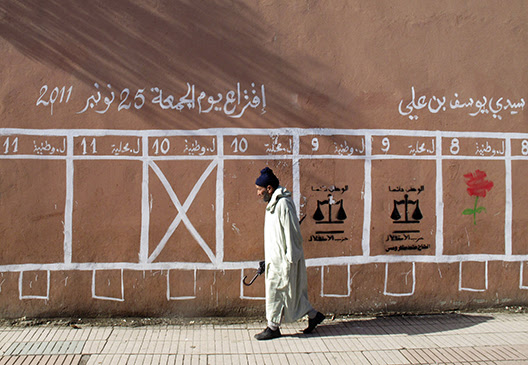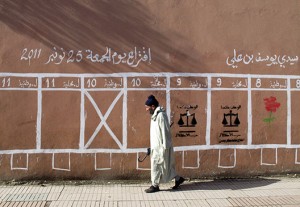Atlantic Council
by Sabina Henneberg
Parliamentary elections scheduled for October 7 mark the end of the five-year mandate of Morocco’s current government led by the Islamist Justice and Development Party (PJD). Approximately 30 political parties will compete for seats in the directly-elected House of Representatives.
The secular Authenticity and Modernity Party (PAM) represents the PJD’s main rival. While important for continuing Morocco’s tradition of political pluralism, the election itself is not representative of a gradual process of deepening political competition or the participation Moroccans hoped for in 2011.
The PJD took control of the government following the parliamentary elections of November 2011, the first after a series of uprisings shook the region earlier that year. Morocco, while not impacted like its neighbors, did see protests that garnered nationwide crowds of tens of thousands, later identified as the February 20 movement. Bringing together diverse interests, one of the movement’s key demands was to reduce the Moroccan monarchy to a parliamentary one – an entirely symbolic role similar to the British or Spanish model. Their demands also included calls for an independent judiciary, freedom of the press, and an end to corruption.
The Constitutional Reform Process
In response to the protests, King Mohamed VI publicly called for comprehensive constitutional reform. He appointed a 19-member advisory commission made up of academics and human rights activists to lead the process. Political parties, labor unions, and civil society organizations were invited to present a memorandum outlining their position on various issues. The king also established a so-called mechanism to operate alongside the commission, including representatives from most political parties and major trade unions. The mechanism’s participation in the process was meant to give a popular stamp of approval to the text drafted by the advisory committee.
Despite these attempts to create a participatory environment, the process remained opaque. Neither the public nor members of parliament were consulted over the appointments to the bodies, both headed by royal advisors. The sessions were not publically broadcast and the debate over the final text took place behind closed doors. Ultimately, the final word on the reforms went neither to the advisory commission nor to the mechanism—both asked only to give recommendations—but rather to the palace. The result was a constitution that guaranteed many individual rights and expanded the powers of parliament, but took incomplete steps toward reducing the king’s powers.
What Did Constitutional Reforms Achieve?
Overall, the new constitution included several liberal reforms, among them eleven rights previously not included, such as the right of access to justice and the right to protection of privacy. The constitution also transferred certain powers from the king to the prime minister, including appointing government officials and dissolving parliament. The prime minister himself, while still appointed by the king, must hail from the majority party in parliament. The actual progress the constitution made toward introducing democratic checks and balances on the monarch, however, remain questionable. The king continues to set the parliamentary agenda each year, and the parliament still lacks the tools for legislative oversight over certain government sectors, such as security. It requires parliament to adopt legislation specifying the terms of the constitution’s promised rights, including freedom of the press. The constitution also places the king at the head of Council of Ministers—responsible for approving legislation—and continues to grant him sole right to amend the constitution.
The eighth in a long series of constitutional reforms, the process reflected for some a certain Moroccan “exceptionalism.” Unlike many of its Arab neighbors following the 2011 uprisings, Morocco had demonstrated that both reform and stability were possible. Even if the result had not fully met protestors’ demands, the adoption of this new constitution via referendum on July 1 (in which 73 percent of registered voters reportedly participated, 98.5 percent of whom voted “yes”) was indicative of the country’s proclivity for gradual, stable change. But with little changing and many flaws in the transparency of the process itself, the grievances of the February 20 movement—mainly corruption and absence of a fully democratic government—remain.
The PJD comes to power
The 2011 parliamentary elections brought the PJD into the governing majority for the first time. The PJD represented to many voters a “fresh alternative” to the established parties whose reputation had suffered. This victory for the party, in which it won 107 out of 395 seats, was also a positive outcome for the monarchy. By creating a chance for an opposition party to govern (the first time was in 1998 in connection with an earlier set of royal reforms meant to enhance democratic legitimacy), the election result allowed the monarchy to continue permitting multi-party politics and channeling political participation without undermining its own power. And, although Morocco does not have a history of Islamist repression like Tunisia or Egypt, the crown’s own authority rests in part on its historical religious legitimacy; the result thus gave the monarchy the appearance of increased tolerance for Islamists.
In spite of its campaign promises of economic and social reform, events during its tenure, including losing its partner party in its ruling coalition, weakened the PJD’s ability to pass key legislation. This, in turn, contributed to a restoration of the status quo in which parties can compete freely in elections, but are unable to realize much-needed structural reforms. In the run-up to this year’s election, the rivalry between the PJD and its main contender, the royally-backed PAM, has been characterized as “hollow” due to the largely superficial differences between their campaigns. Rather than differentiating themselves through their programs (both parties are proposing similar platforms based on long-term economic development), the two parties are focusing their rivalry on partisan accusations, while other parties campaign on unrealistic promises. Even if the PJD is successful in retaining the largest share of parliamentary seats (a likely outcome), the results will do little to change the current status quo.
Demonstrations of public anger toward and a lack of cohesion within the government, combined with the renewed strength of the king, also suggest the upcoming elections are a sideshow within a larger story of a lack of reform and continued corruption. Thousands marched against Prime Minister and PJD Secretary General Abdelilah Benkirane on September 18 in protests sparked by a series of leaks over corruption scandals. In the wake of a July report over Morocco’s importation of toxic waste from Italy, the Minster of Environment accused her rivals of trying to damage her reputation; meanwhile, in response to a leaked list of government officials receiving land at below-market value, the Ministers of Interior and Finance defended the purchases. All three implicated ministers were members of the PJD’s governing coalition.
The consequences of the 2011 Arab uprisings in Morocco, while certainly exceptional, are far from clear. The palace is continuing to convey the image that the country has found a “formula for stability” and is moving along a path of gradual democratic reform, while the promises of 2011 remain largely unfulfilled.
Sabina Henneberg is a PhD Candidate at the Johns Hopkins University School of Advanced International Studies.








